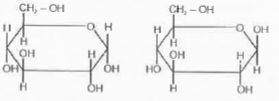Name the smallest aldose which forms cyclic hemiacetal and the functional groups are involved in its formation.
To solve the question, we need to identify the smallest aldose that can form a cyclic hemiacetal and determine the functional groups involved in its formation.
1. Identify the Smallest Aldose:
- An aldose is a type of sugar (monosaccharide) that contains an aldehyde group. The smallest aldose is D-glyceraldehyde, which has three carbon atoms (C3H6O3).
2. Understanding Cyclic Hemiacetal Formation:
- Aldoses can undergo cyclization to form cyclic structures. In the case of D-glyceraldehyde, the aldehyde group (–CHO) reacts with one of its hydroxyl groups (–OH) to form a cyclic hemiacetal.
3. Drawing the Structure:
- The structure of D-glyceraldehyde can be represented as:
CHO|CH2OH|OH
- When D-glyceraldehyde cyclizes, the carbonyl carbon (C1) reacts with the hydroxyl group on C2, leading to the formation of a five-membered ring.
4. Functional Groups Involved:
- The functional groups involved in the formation of the cyclic hemiacetal are:
- The aldehyde group (–CHO) at C1.
- The hydroxyl group (–OH) at C2.
5. Resulting Structure:
- The resulting cyclic structure is a hemiacetal, which can be represented as:
OHOH||CC||HH
Summary:
- The smallest aldose that forms a cyclic hemiacetal is D-glyceraldehyde.
- The functional groups involved in its formation are the aldehyde group and a hydroxyl group.
- An aldose is a type of sugar (monosaccharide) that contains an aldehyde group. The smallest aldose is D-glyceraldehyde, which has three carbon atoms (C3H6O3).
- Aldoses can undergo cyclization to form cyclic structures. In the case of D-glyceraldehyde, the aldehyde group (–CHO) reacts with one of its hydroxyl groups (–OH) to form a cyclic hemiacetal.
- The structure of D-glyceraldehyde can be represented as:
CHO|CH2OH|OH
- When D-glyceraldehyde cyclizes, the carbonyl carbon (C1) reacts with the hydroxyl group on C2, leading to the formation of a five-membered ring.
- The functional groups involved in the formation of the cyclic hemiacetal are:
- The aldehyde group (–CHO) at C1.
- The hydroxyl group (–OH) at C2.
- The resulting cyclic structure is a hemiacetal, which can be represented as:
OHOH||CC||HH
- The smallest aldose that forms a cyclic hemiacetal is D-glyceraldehyde.
- The functional groups involved in its formation are the aldehyde group and a hydroxyl group.
Topper's Solved these Questions
- BIOMOLECULESBOOK - CENGAGE CHEMISTRY ENGLISHCHAPTER - BIOMOLECULESEXERCISE - Exercises (Concept Application)
25 Videos
- BIOMOLECULESBOOK - CENGAGE CHEMISTRY ENGLISHCHAPTER - BIOMOLECULESEXERCISE - Exercises (Linked Comprehension)
36 Videos
- BIOMOLECULESBOOK - CENGAGE CHEMISTRY ENGLISHCHAPTER - BIOMOLECULESEXERCISE - Exercises Archives (Analytical And Descriptive)
8 Videos
- AROMATIC COMPOUNDS AND ALKYL AND ARYL HALIDES BOOK - CENGAGE CHEMISTRY ENGLISHCHAPTER - AROMATIC COMPOUNDS AND ALKYL AND ARYL HALIDES EXERCISE - Archives Subjective Type
4 Videos
- CARBOXYLIC ACIDS AND THEIR DERIVATIVESBOOK - CENGAGE CHEMISTRY ENGLISHCHAPTER - CARBOXYLIC ACIDS AND THEIR DERIVATIVESEXERCISE - Exercises Archives (Analytical And Descriptive)
34 Videos
Similar Questions
The smallest aldose which is able to form cyclic hemiacetal is/are:
View SolutionName the functional group present in HCOOH.
View SolutionName the functional group present in CH3CHO .
View SolutionName the functional group present in C2H5Cl.
View SolutionName the functional group present in C2H5COOH
View SolutionWhich of the following is not involved in Rainbow formation?
View SolutionA substance forms zwitter ion, it can have functional groups −
View SolutionMention the functional group of amino acids involved in the formation of a peptide bond.
View SolutionName the functional group present in CH3COCH3
View SolutionTwo cyclic hemiacetal forms of glucose given below are called as

View Solution
